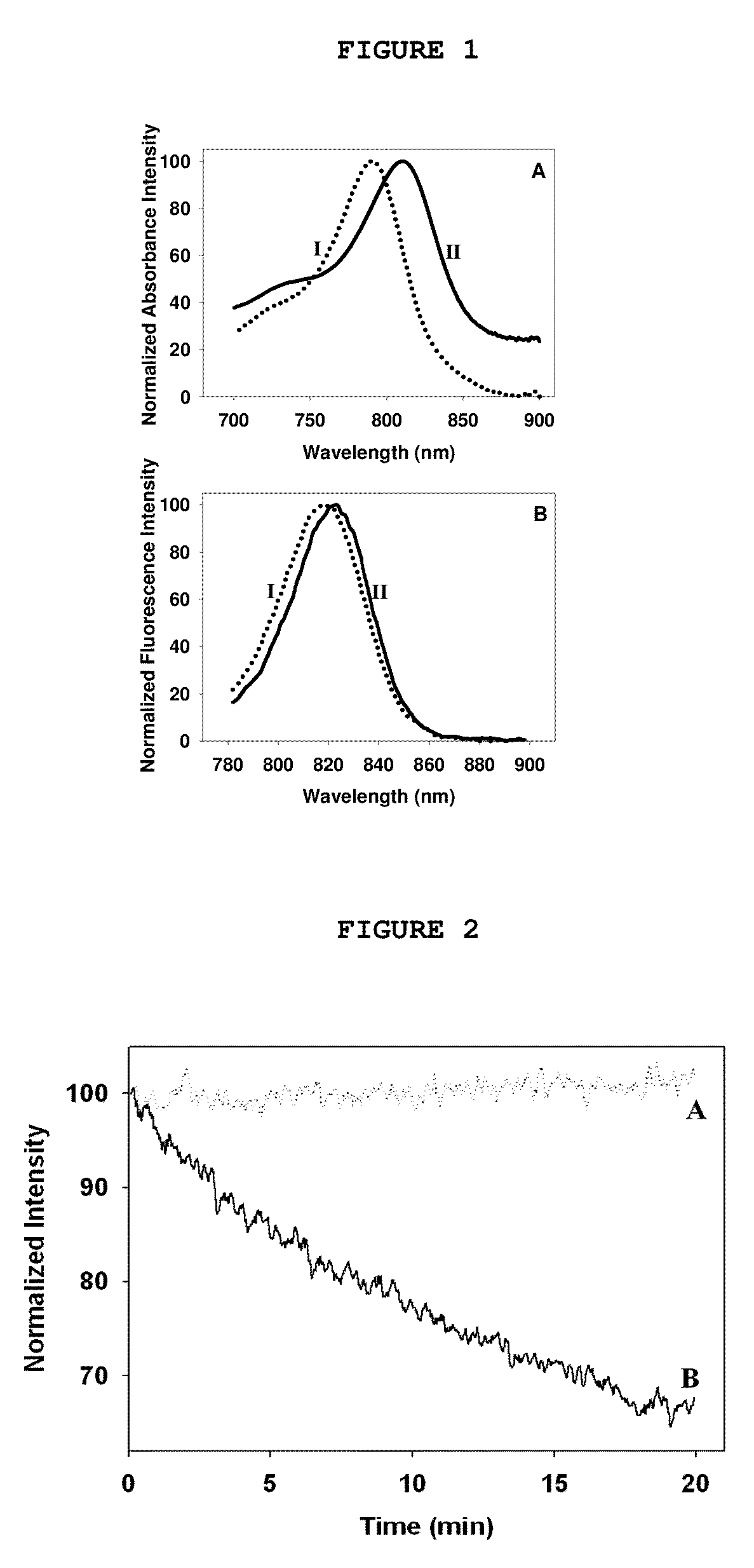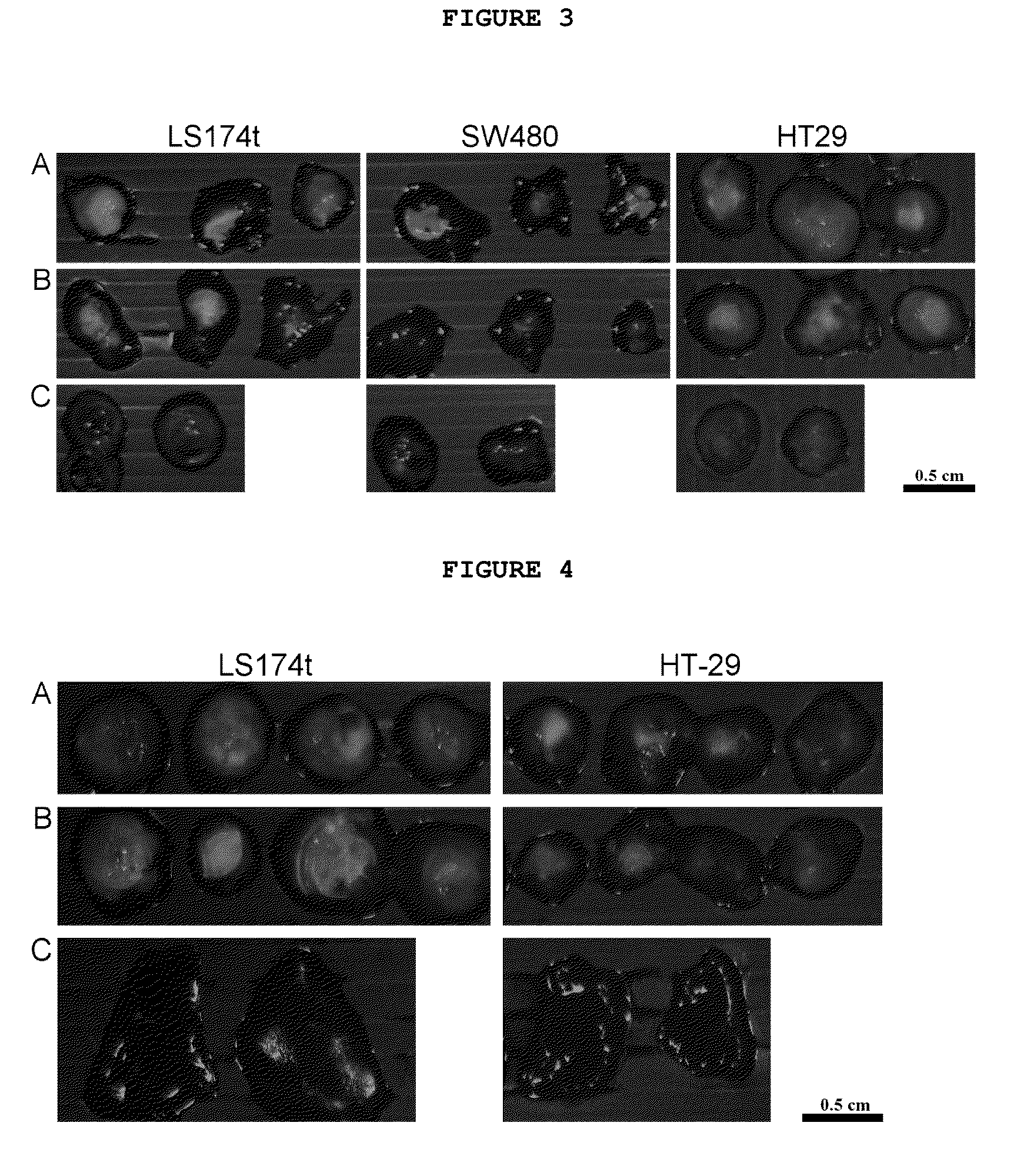Synthesis and characterization of near IR fluorescent magnetic and non-magnetic albumin nanoparticles for biomedical applications
a fluorescent magnetic and non-magnetic albumin nanoparticle technology, applied in the field of nanometer-sized albumin particles, can solve the problems of albumin nanoparticles containing entrapped nir cyanine dyes, less desirable methods of attaching dyes, and changes in surface chemistry and properties of particles
- Summary
- Abstract
- Description
- Claims
- Application Information
AI Technical Summary
Benefits of technology
Problems solved by technology
Method used
Image
Examples
example 1
Synthesis of Albumin Nanoparticles Containing CANIR Dye
[0227]An aqueous solution (6.25 mL) of HSA (250 mg) and CANIR (1.25 mg) was prepared. Ethanol (12.5 mL) was added, and the mixture was stirred for 15 minutes at 800 rpm. The mixture was heated to 70° C. and stirred for a further 4 hours. The temperature was then increased to 78° C., for ethanol evaporation. Excess ethanol was removed by dialysis against water or PBS and the particles were further separated from impurities by crosslinked dextran gel filtration. The particles obtained were 100±15 nm in dry diameter, as shown in a SEM image. Concentrations and volumes of water, temperature, ethanol or an alternative organic solvent, HSA and CANIR are variable, for variation of particle size and fluorescence intensity. Besides this desolvation method, various other methods in addition of the NIR dye may also be used for synthesis of albumin particles, e.g., a pH-coacervation method, crosslinking with glutaraldehyde method or emulsif...
example 2
Synthesis of Magnetic NIR Dyed Albumin Nanoparticles
[0231]An aqueous solution (5 mL) containing HSA (200 mg) and CANIR (1 mg) was prepared. Ferro-fluid (100 μL containing 5 mg iron oxide) was added, and the mixture was stirred for 15 minutes at 800 rpm. The mixture was heated to 70° C. and stirred for a further 4 hours. Excess reagents were removed by dialysis against water or PBS and the particles were further separated from impurities by a magnetic gradient column. Concentrations and volumes of water, ferro-fluid, HSA and CANIR are variable, for variation of particle size, magnetic properties and fluorescence intensity.
[0232]Besides this desolvation method, various other methods in addition of the NIR dye may also be used for synthesis of albumin particles, e.g., a pH-coacervation method, crosslinking, for example by the glutaraldehyde method or emulsification method [Langer, Balthasar et al., Int. J. Pharm., 2003, 257(1-2) 169-180]. Crosslinking is also possible using other polya...
example 3
Synthesis of Core-Shell NIR-HSA Coated Magnetic Iron Oxide Nanoparticles
[0235]Core Particles:
[0236]Iron oxide (10) core nanoparticles were prepared in 2 ways:
[0237]First way: Nanoparticles with narrow size distribution were prepared by nucleation followed by controlled growth of magnetic iron oxide thin films onto gelatin / iron oxide nuclei, as described in detail in EC 10880315 (2003); IL 139638 (2006). Briefly, an FeCl2 solution (10 mmol / 5 ml H2O) was added to an aqueous solution (80 mL) of gelatin (200 mg) at 60° C., followed by a NaNO2 solution (7 mmol / 5 ml H2O). The mixture was shaken at 60° C. for 10 minutes, and NaOH aqueous solution (1 N) was added until a pH of 9.5 was achieved. This procedure for growth of magnetic films onto gelatin nuclei was repeated four times. The formed magnetic nanoparticles were then washed from excess reagents using magnetic gradient columns. The particles formed were 15±1.2 nm in dry diameter, as shown in a TEM image. The number of cycles of growt...
PUM
| Property | Measurement | Unit |
|---|---|---|
| Temperature | aaaaa | aaaaa |
| Temperature | aaaaa | aaaaa |
| Temperature | aaaaa | aaaaa |
Abstract
Description
Claims
Application Information
 Login to View More
Login to View More - R&D
- Intellectual Property
- Life Sciences
- Materials
- Tech Scout
- Unparalleled Data Quality
- Higher Quality Content
- 60% Fewer Hallucinations
Browse by: Latest US Patents, China's latest patents, Technical Efficacy Thesaurus, Application Domain, Technology Topic, Popular Technical Reports.
© 2025 PatSnap. All rights reserved.Legal|Privacy policy|Modern Slavery Act Transparency Statement|Sitemap|About US| Contact US: help@patsnap.com



